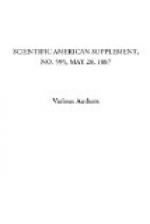I would ask you to notice which color is most luminous. I think that no one will dispute that in the yellow we have the most intense luminosity, and that it fades gradually in the red on the one side and in the violet on the other. This, then, may be called a qualitative estimate of relative brightnesses; but I wish now to introduce to you what was novel last year, a quantitative method of measuring the brightness of any part.
Before doing this I must show you the diagram of the apparatus which I shall employ in some of my experiments.
[Illustration: FIG. 1.—COLOR PHOTOMETER.]
RR are rays (Fig. I) coming from the arc light, or, if we were using sunlight, from a heliostat, and a solar image is formed by a lens, L_{1}, on the slit, S_{1} of the collimator, C. The parallel rays produced by the lens, L_{2}, are partially refracted and partially reflected. The former pass through the prisms, P_{1}P_{2}, and are focused to form a spectrum by a lens, L_{3}, on D, a movable ground glass screen. The rays are collected by a lens, L_{4}, tilted at an angle as shown, to form a white image of the near surface of the second prism on F.
Passing a card with a narrow slit, S_{2}, cut in it in front of the spectrum, any color which I may require can be isolated. The consequence is that, instead of the white patch upon the screen, I have a colored patch, the color of which I can alter to any hue lying between the red and the violet. Thus, then, we are able to get a real patch of very approximately homogeneous light to work with, and it is with these patches of color that I shall have to deal. Is there any way of measuring the brightness of these patches? was a question asked by General Festing and myself. After trying various plans, we hit upon the method I shall now show you, and if any one works with it he must become fascinated with it on account of its almost childish simplicity—a simplicity, I may remark, which it took us some months to find out. Placing a rod before the screen, it casts a black shadow surrounded with a colored background. Now I may cast another shadow from a candle or an incandescence lamp, and the two shadows are illuminated, one by the light of the colored patch and the other by the light from an incandescence lamp which I am using tonight. [Shown.] Now one stripe is evidently too dark. By an arrangement which I have of altering the resistance interposed between the battery and the lamp, I can diminish or increase the light from the lamp, first




